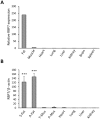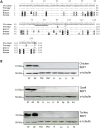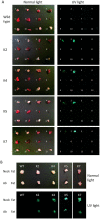Identification of the avian RBP7 gene as a new adipose-specific gene and RBP7 promoter-driven GFP expression in adipose tissue of transgenic quail
- PMID: 25867079
- PMCID: PMC4395105
- DOI: 10.1371/journal.pone.0124768
Identification of the avian RBP7 gene as a new adipose-specific gene and RBP7 promoter-driven GFP expression in adipose tissue of transgenic quail
Abstract
The discovery of an increasing number of new adipose-specific genes has significantly contributed to our understanding of adipose tissue biology and the etiology of obesity and its related diseases. In the present study, comparison of gene expression profiles among various tissues was performed by analysis of chicken microarray data, leading to identification of RBP7 as a novel adipose-specific gene in chicken. Adipose-specific expression of RBP7 in the avian species was further confirmed at the protein and mRNA levels. Examination of the transcription factor binding sites within the chicken RBP7 promoter by Matinspector software revealed potential binding sites for adipogenic transcription factors. This led to the hypothesis that the RBP7 promoter can be utilized to overexpress a transgene in adipose tissue in order to further investigate the function of a transgene in adipose tissue. Several lines of transgenic quail containing a green fluorescent protein (GFP) gene under the control of the RBP7 promoter were generated using lentivirus-mediated gene transfer. The GFP expression in transgenic quail was specific to adipose tissue and increased after adipocyte differentiation. This expression pattern was consistent with endogenous RBP7 expression, suggesting the RBP7 promoter is sufficient to overexpress a gene of interest in adipose tissue at later developmental stages. These findings will lead to the establishment of a novel RBP7 promoter cassette which can be utilized for overexpressing genes of interest in adipose tissue in vivo to study the function of genes in adipose tissue development and lipid metabolism.
Conflict of interest statement
Figures





Similar articles
-
Adipose-specific expression of mouse Rbp7 gene and its developmental and metabolic changes.Gene. 2018 Sep 5;670:38-45. doi: 10.1016/j.gene.2018.05.101. Epub 2018 May 24. Gene. 2018. PMID: 29803924
-
Identification of the MUC2 Promoter as a Strong Promoter for Intestinal Gene Expression through Generation of Transgenic Quail Expressing GFP in Gut Epithelial Cells.Int J Mol Sci. 2017 Jan 19;18(1):196. doi: 10.3390/ijms18010196. Int J Mol Sci. 2017. PMID: 28106824 Free PMC article.
-
Cloning of comparative gene identification-58 gene in avian species and investigation of its developmental and nutritional regulation in chicken adipose tissue.J Anim Sci. 2011 Nov;89(11):3490-500. doi: 10.2527/jas.2011-3897. Epub 2011 Jun 3. J Anim Sci. 2011. PMID: 21642491
-
Avian bioresources for developmental biology: Chicken and quail resources in the United Kingdom, France, and Japan.Dev Biol. 2025 May;521:1-13. doi: 10.1016/j.ydbio.2025.02.001. Epub 2025 Feb 2. Dev Biol. 2025. PMID: 39904408 Review.
-
Virus-based gene transfer approaches and adipose tissue biology.Curr Gene Ther. 2008 Apr;8(2):79-87. doi: 10.2174/156652308784049354. Curr Gene Ther. 2008. PMID: 18393829 Review.
Cited by
-
Identification of differentially expressed genes and pathways for intramuscular fat metabolism between breast and thigh tissues of chickens.BMC Genomics. 2018 Jan 16;19(1):55. doi: 10.1186/s12864-017-4292-3. BMC Genomics. 2018. PMID: 29338766 Free PMC article.
-
Identification of the Differentially Expressed Genes of Muscle Growth and Intramuscular Fat Metabolism in the Development Stage of Yellow Broilers.Genes (Basel). 2020 Feb 26;11(3):244. doi: 10.3390/genes11030244. Genes (Basel). 2020. PMID: 32110997 Free PMC article.
-
Distinct genes and pathways associated with transcriptome differences in early cardiac development between fast- and slow-growing broilers.PLoS One. 2018 Dec 5;13(12):e0207715. doi: 10.1371/journal.pone.0207715. eCollection 2018. PLoS One. 2018. PMID: 30517173 Free PMC article.
-
Heart-specific expression of the green fluorescent protein gene in avian embryos by administration of recombinant adenovirus type-5 vector into the embryonic blood vessel.Front Physiol. 2024 Sep 27;15:1467489. doi: 10.3389/fphys.2024.1467489. eCollection 2024. Front Physiol. 2024. PMID: 39397854 Free PMC article.
-
Current Approaches and Applications in Avian Genome Editing.Int J Mol Sci. 2020 May 30;21(11):3937. doi: 10.3390/ijms21113937. Int J Mol Sci. 2020. PMID: 32486292 Free PMC article. Review.
References
-
- Ross AC. Cellular metabolism and activation of retinoids: roles of cellular retinoid binding proteins. FASEB J. 1993; 7: 317–27. - PubMed
Publication types
MeSH terms
Substances
LinkOut - more resources
Full Text Sources
Other Literature Sources

